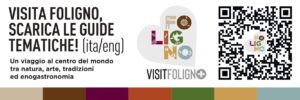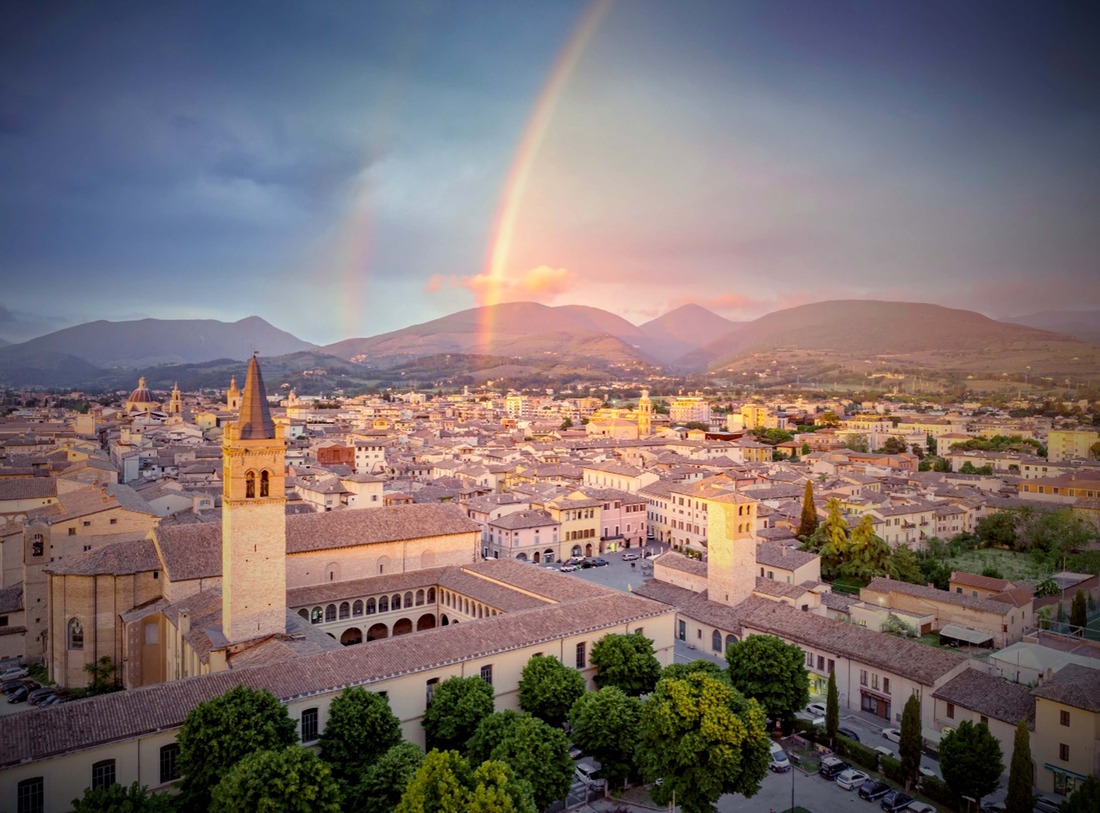By Our Editorial Staff
An ancient tradition has it that Foligno is at the center of Italy, at the centre of the Mediterranean, at the centre of the world, it is precisely “lu centro de lu munnu”. To be precise, the exact point would be the red pin placed in the centre of the billiard table of the historic ‘Caffè Sassovivo’. The city, in the green heart of Umbria, welcomes visitors with an authentic and vital atmosphere: its thousand-year history blends with the pleasure of everyday life. The historic center, cozy and easily accessible on foot and by bicycle, preserves a surprising artistic and architectural heritage.
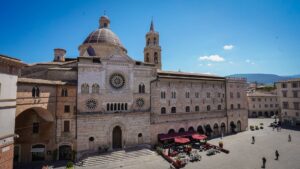
The historic centre: a jewel to be slowly discovered
The heart of the city is Piazza della Repubblica, overlooked by some of the most important buildings: the Duomo, with its Romanesque façade and Baroque interior; the Palazzo Comunale, an elegant example of neoclassical architecture; Palazzo Trinci, a noble residence of the fourteenth century, which now houses the City Museum; Palazzo Orfini, home to the Museum of Printing where the first printed edition of the Divine Comedy was made in 1472.
The indissoluble bond of the city with the supreme poet is celebrated and enriched every year with the ‘Dante Days’ event.
In this same square, in 1206, St. Francis renounced his father’s possessions and began his spiritual journey, an episode evoked by the beautiful bronze monument by Pietro Battoni.
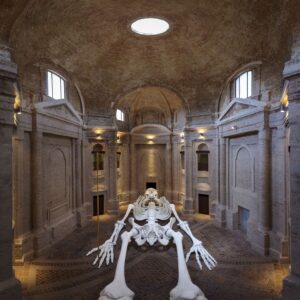
Between museums and contemporary art
Foligno also surprises with the variety of its museums and places of art: the Oratory of the Nunziatella preserves a masterpiece by Perugino, while the Oratory of the Crucifix is a triumph of the Baroque. The Diocesan Museum, located in the beautiful Palazzo delle Canoniche, preserves precious liturgical furnishings, paintings and sculptures of sacred art. Just outside the centre, in the former church of the Holy Trinity in Annunziata, there is one of the most enigmatic works of the Italian twentieth century: the Cosmic Calamity by Gino De Dominicis, a gigantic human skeleton over 24 meters long, with a beak instead of a nose. A powerful and surreal work, which fascinates and questions.
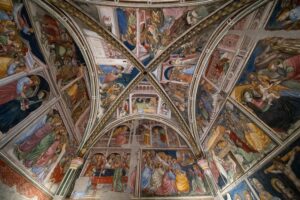
Trinci Palace
Among the most precious jewels of Foligno undoubtedly stands out Palazzo Trinci, residence of the family that ruled the city between the fourteenth and fifteenth centuries. The palace is an extraordinary example of late Gothic architecture and houses one of the most important pictorial decorations of the Umbrian fifteenth century. The frescoes created by Gentile da Fabriano and other collaborators tell stories of myths, religion and power such as the Hall of the Giants, with its monumental Roman emperors, and the Chapel of Ottaviano Nelli with the Stories of the Virgin Mary. The palace also houses the Archaeological Museum and the Civic Art Gallery, as well as temporary exhibitions, making it a real cultural centre.
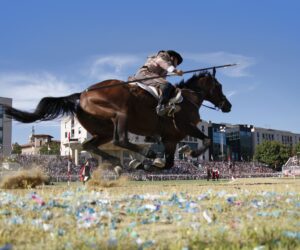
Events and traditions: living Foligno
Foligno is a lively city that celebrates its identity with heartfelt and participated events. The most famous is undoubtedly the Giostra della Quintana, a seventeenth-century historical re-enactment in which the city districts challenge each other in a spectacular horse race. The event is held in June and September and for two weeks the city is in turmoil: the flags of the districts wave everywhere, the sound of drums echoes in the streets, the historic taverns welcome patrons. Do not miss the Procession in Baroque clothes and the multimedia museum of the Quintana, housed in Palazzo Candiotti.
In summer, the courtyard of Palazzo Trinci is transformed into a stage for the Summer at Trinci, with music, theatre and dance in the open air.
September is the richest month of events: it begins with the Segni Barocchi festival, which animates the most beautiful places in the city with concerts, shows and conferences, culminating in the spectacular Baroque Night. Then La Francescana, a historic cycle with vintage bikes and vintage clothes that travels the Umbrian hills and attracts enthusiasts from abroad. Finally, I Primi d’Italia, the first festival dedicated to the first courses of Italian cuisine. A great event in which, for four days, the historic centre is filled with flavours, show-cooking and tastings from all over Italy.
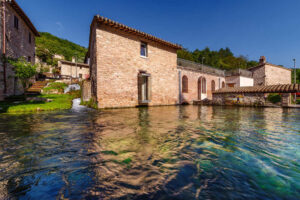
The territory: nature, villages and spirituality
Just outside the city walls opens up an enchanting territory, between hills, woods and small villages that seem suspended in time. One of the most fascinating areas is the Menotre Valley, with its nature trails, waterfalls and cliffs. Obligatory stops are Pale, with its karst caves and the ancient hermitage of Santa Maria Giacobbe set in the mountain and Rasiglia, known as “the village of waters”, crossed by streams and canals that flow between the stone houses and the ancient factories.
Higher up, towards the Apennines, extends the Colfiorito Park, a protected area characterized by a marsh at high altitude, one of the most important wetlands in central Italy. A territory characterized by wide plateaus and gentle undulations. It is a destination for many species of migratory birds and biodiversity is the protagonist here. It is an ideal place for birdwatchers and nature photography enthusiasts, offers trails to walk or bike, viewpoints and two museums to visit: the Naturalistic Museum and the Archaeological Museum. The area is also famous for its typical productions of excellence, such as cereals and legumes, including lentils, and the tasty IGP red potato.
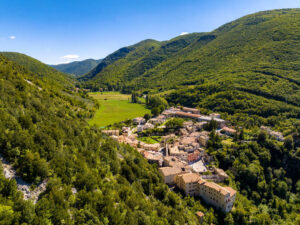
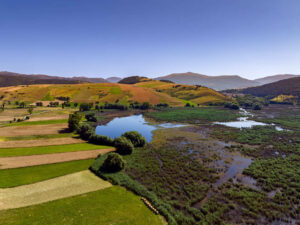
On the soul’s paths
The Foligno area is crossed by important spiritual paths, which combine scenic beauty and inner reflection. The Via di Francesco, which passes through the historic centre, connects Assisi to Spoleto and continues through the Apennine mountains. The Via Lauretana, on the other hand, crosses the Colfiorito plateau, offering suggestive views up to the Sanctuary of Loreto. Finally, the Franciscan Way of the Marca leads from Assisi to Ascoli Piceno, touching the Hermitage of Santa Maria Giacobbe, set in the rock above Pale.
Coming to Foligno means immersing yourself in an authentic experience, made up of art, nature, history and quality of life. It is a destination that knows how to surprise with its discretion, conquer with its hospitality and leave the desire to return. Whether it’s for a weekend or for a longer stay, Foligno will give you real emotions.
Info: Ufficio Informazioni e Accoglienza Turistica (Iat) Valle Umbra / Porta Romana, Corso Cavour 126, 06034 Foligno (Pg) / Tel 0742 354459 – 354165 / email: servizio.turismo@comune.foligno.pg.it / www.comune.foligno.pg.it/turismo/ / facebook e instagram: visit.foligno
